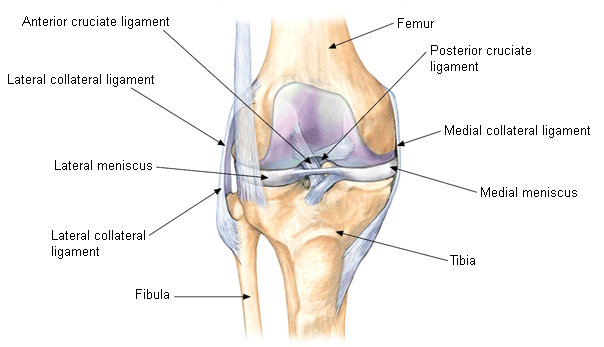Patellofemoral Joint
- Home
- Knee
- Common Ailments
- Patellofemoral Joint
Patellofemoral Joint (PFJ) Pain syndrome describes symptoms felt around the front of the knee. It can affect all ages and genders but is common in teenage girls and sports people. It can start for a variety of reasons but is effectively treated with the correct treatment. Pain can vary from occasion sharp pains to severe burning pain making climbing stair and even walking difficult.
Later in life it is common to get osteoarthritis in the PFJ. This involves the wearing out of the back of the patella, the grove it slides in or both.
The patellofemoral joint is the joint between the patella (kneecap) and the front of the femur (thigh bone). Thick cartilage covers the back of the patella so it can withstand large pressures and glide easily in the groove on the front of the femur (Trochlea Grove). It is held by several small ligaments and the joint capsule and also supported by the quadriceps muscles. The tendon of the quadriceps passes over the top of the patella and inserts into the tibial tuberosity (a small bump if bone on the front of the shin).

There is not one specific cause of PFJ pain but there may be several factors, which may lead to someone suffering with symptoms.
- Overuse – repetitive activity or starting a new sport can irritate the joint, patella tendon or other soft tissues on the front of the knee
- Lack of flexibility – tightness of the hamstrings or iliotibial band (a band that runs along the edge of the thigh) can increase the pressure that the patella is under. The capsule and fascia around the patella can also have this effect.
- Muscle weakness and co ordination – weakness of several muscles in the leg can lead to increased pressure on the PFJ. The quadriceps are the main muscles associated with movement of the PFJ but the hip muscles (gluteus minimus, medius and maximus) are also essential in providing support in all activities.
- Mal-tracking – Tightness and weakness can cause the patella to move side to side rather than smoothly through the Trochlea Groove. The patella may 'jump' or click during movements which causes increased pressure through the joint. Some people are born with small or large patella or deep or shallow grooves which can also cause the patella to track incorrectly.
- Feet – High or fallen (often called over pronated) arches of the feet or stiffness in the ankles or toes may contribute to PFJ dysfunction. Altered foot movements can cause increased pressure up the whole leg, putting excess pressure on the PFJ.

- Pain in the knee. This can be a dull burning pain at the front of the knee or behind the patella or a more sharp catching type pain during activity.
- Pain is usually aggravated by running, climbing stairs, squatting or sitting for long period with the legs still.
- Swelling. This is not quite a common as with other injuries of the knee but the front of the knee can look puffy and feel hot in more severe cases.
- Clicking and clunking. This may be from the patella tracking incorrectly or because of wear behind the patella. It is not always painful and plenty of people have 'clicky' knees but no other symptoms.

Identifying the likely cause or number of causes is essential to the successful treatment of PFJ pain.
Short term relief and early intervention involves reducing pressure through the joint by stopping the aggravating activities as much as possible. Short term use of painkillers or anti-inflammatory drugs or gel may reduce discomfort. Taping the patella (using a specific kind of tape) in certain ways can help offload the painful areas and possibly help the patella to track better. It may also make normal daily activities or sports more comfortable.
Stretching and mobilising of all tight structures is vital and may be achieved through a combination of specific soft tissue release techniques, trigger point release, patella stretches and standard muscle stretches. The patient can be taught to do many of these treatments at home. It is then important to begin strengthening and improving the control of any muscles especially the Gluteals and quadriceps.
Ensuring that you have the correct footwear for you foot type and the activities you do is important. A physiotherapist or podiatrist can make recommendations on these. If there are more pronounced alignment problems with your feet then insoles made specifically for the patient may be helpful. It is worth noting that high heels are the worst type of footwear for increasing pressure through the patella and are best avoided when you have PFJ pain.
